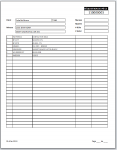SirTKC
Art Systems Canada Inc.
- Local time
- Yesterday, 22:03
- Joined
- Apr 28, 2015
- Messages
- 14
Hi there,
I don't know if its possible but I would like to add "blank" records in order to fill the rest of the details section of the report.
Lets just say for example that I have room for 20 lines in my report. But have only 13 records in my query results that will fill that report. I'dd like the printout to show 13 strings + 12 blanks as a "grid".
Thing is, there is some results that returns 29 strings. So the same rule has to apply to the second page. The first page will be filled with 25 strings and the next one with 4 strings + 21 blanks.
And so on. I thought it would be an easy thing to add "dummy records", but apparently not... At least for me ! :-(
Is it possible using VBA ?
I don't know if its possible but I would like to add "blank" records in order to fill the rest of the details section of the report.
Lets just say for example that I have room for 20 lines in my report. But have only 13 records in my query results that will fill that report. I'dd like the printout to show 13 strings + 12 blanks as a "grid".
Thing is, there is some results that returns 29 strings. So the same rule has to apply to the second page. The first page will be filled with 25 strings and the next one with 4 strings + 21 blanks.
And so on. I thought it would be an easy thing to add "dummy records", but apparently not... At least for me ! :-(
Is it possible using VBA ?

